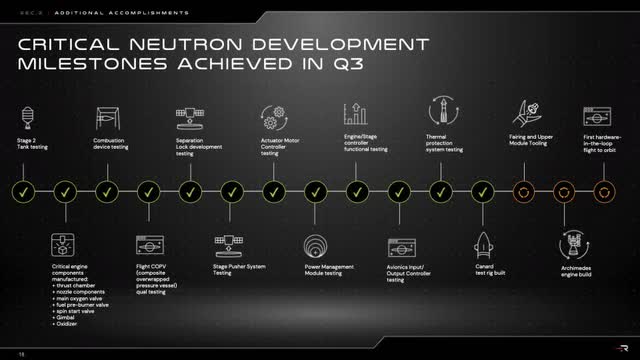On September 19, Rocket Lab’s 41st Electron mission experienced a second stage failure. This was Rocket Lab’s first unsuccessful launch since May 2021, when the 20th Electron mission failed. Rocket Lab’s shares trade around the same level as prior to the launch failure, and about 40% lower than highs in July.
Rocket Lab has now been approved for the FAA to return to flight operations and the next Electron launch is scheduled for December 15. I think the current slump in stock price represents an attractive buy point, and sentiment surrounding Rocket Lab could see a recovery as Electron returns to the launch pad. There are a few reasons for this assessment, which I discuss below.
Rocket Lab’s Explanation Seems Credible
Rocket Lab recently closed the inquiry into its unsuccessful Electron mission. Here is what the company concluded:
The findings of the investigation overwhelmingly indicate that an unexpected electrical arc occurred within the power supply system that provides high voltage to the Rutherford engine’s motor controllers, shorting the battery packs that provide power to the launch vehicle’s second stage…. The arc was likely only made possible by the rare interaction of multiple conditions. Any one of these factors on their own would likely not have caused the failure of the second stage, but when they occur simultaneously… they reach the threshold… for an arc to form and travel. Three rare conditions had to present simultaneously in the low-pressure space environment to reach the threshold for arcing… including:
- A superimposed alternating current (‘AC’) with the direct current (‘DC’) high-voltage electricity provided to the stage’s power supply system, that is produced as a ripple voltage from the system’s engine motor controllers;
- A small concentration of helium and nitrogen gasses that were present within the interstage between Electron’s first and second stages; and
- An imperceptible fault in the insulation of the high voltage loom within the power supply system.”
The investigation was accompanied with some design changes to prevent re-occurrence of the issue.
To me (as a non-technical person), Rocket Lab’s claim that the second stage failure was caused by a rare anomaly seems credible for the very simple reason that it had not occurred during Electron’s previous 40 launches. It is not a regular occurrence.
Moreover, Rocket Lab has also received FAA approval to resume flight operations, which should give investors further confidence that Rocket Lab’s explanation and fix are credible.
And so as we approach the next launch, I think there is a good likelihood that Electron operations will soon return to normal. Of course, this is rocket science, so new problems can always still arise.
Electron Demand Remains Strong
In the Q3 earnings release, Rocket revealed a busy launch schedule for Electron in 2024. Electron is scheduled for 22 flights, with 8 launches in Q4 2024. Per the earnings call, “the manifest is essentially full,” and Rocket Lab is scheduled to launch every rocket that it can produce next year.
Rocket Lab also reported strong demand for the HASTE variant of the Electron, with 7 launch contracts booked over the previous six months.
Rocket Lab has previously guided that Electron should achieve profitability at 6 launches/quarter. Rocket Lab is set to average 5.5 launches/quarter next year, and the 8 launches in Q4 could potentially mark the point beyond which Electron achieves long-term profitability. We don’t have concrete guidance for 2025 yet, so investors will have to wait and see.
Thus, despite the launch failure, the demand outlook and launch cadence for Electron are looking very good in 2024. This suggests that there may be limited impact on the launch business from the unsuccessful mission.
Of course, Electron was in a good position to begin with. As I have discussed in a previous article titled “Rocket Lab: The Downside Risk Profile Is Reassuring,” Electron has achieved a virtual monopoly in the small launch market. There is nowhere else for customers to really go, which should shield Rocket Lab from significant long-term negative impact due to the September launch failure.
However, Electron May Be On Thin Ice
All this being said, there is at least one significant issue that does persist as Electron returns to the pad: Electron is on (somewhat) thin ice for the next few quarters.
The launch failure has worsened Electron’s reliability statistics, and although they are still very good, the drop in reliability can only be unhelpful. Still, as long as Rocket Lab is selling every rocket it can make, the decline in reliability statistics by itself may not matter much.
What does matter, though, is that the recent launch failure puts Electron on thin ice. Were Rocket Lab to experience another launch failure (for whatever reason) over the next 10-15 launches, then failure might start to look more like a habit than an anomaly. Another failure within the next 2-4 quarters could potentially send shares tumbling lower, and does present a material short- to medium-term risk for investors.
Solid Progress Everywhere Else
In the meantime, since the mission failure, Rocket Lab reported solid progress outside of Electron.
Space systems grew at 16.9% quarter-over-quarter. Rocket Lab reported a “new spacecraft order for a constellation customer [that] includes full-suite of Rocket Lab products [including] star trackers, reaction wheels, solar panels, separation system, S-band and L-band radios, flight software, ground software, [and] mission operations.” This could turn out to be quite a lucrative contract considering it is for a constellation customer and that they are purchasing a slew of Rocket Lab products.
Rocket Lab also reported that in Q1 2024 it will start delivery of its 17 spacecraft order worth $143 million from MDA.
In addition, Rocket Lab is now another quarter along the road to Neutron development. In Q3, Rocket Lab completed a slew of tests, including cryogenic testing and early testing of the Neutron’s upcoming Archimedes engine.
Neutron Development Milestones Q3 2023 (Rocket Lab Q3 2023 Earnings Presentation)
As I have noted in an earlier article titled “Rocket Lab: Electron Launch Business Set To Grow,” Neutron could plausibly generate more revenue than Electron and space systems combined. Neutron launches will be priced at $50m-$55m, and the rocket is designed for relatively straightforward reusability. Hence, Neutron could potentially dwarf both Electron and space systems if it gets up to a launch cadence of, say, 20 launches per year in 2025 or 2026 (i.e., around $1b in revenue). Neutron revenues would then be around 6x larger than what Electron is guided for in 2024. As such, Neutron development remains the most intriguing part of Rocket Lab, and continued progress here is a very positive development for long-term investors.
Finally, Rocket Lab’s balance sheet remains strong and they should have a runway through the end of Neutron development barring setbacks of more than a couple of quarters.
Investor Takeaway
Although the unsuccessful Electron mission is by no means good for Rocket Lab, and does increase the stock’s riskiness for the time being, I think that these negative developments are offset by progress outside of Electron and, more importantly, the very attractive share price not far off 52-week lows.
I had previously rated Rocket Lab a strong buy in July when shares were trading at $7.5. Since then, of course the launch failure hurts, but shares are now trading at $4.6 (at time of writing). On balance, I think that despite the turbulence, Rocket Lab remains a strong buy.
Read the full article here


